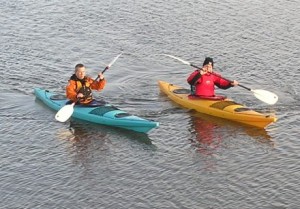 I’m quietly confident that as a loyal and knowledgeable reader of The Boating Hub’s blog you’ll already know the difference between a canoe and a kayak, and that when most people talk about canoes, they’re really talking about a kayak. But if you’re in the market to buy a new kayak, what factors should you consider?
I’m quietly confident that as a loyal and knowledgeable reader of The Boating Hub’s blog you’ll already know the difference between a canoe and a kayak, and that when most people talk about canoes, they’re really talking about a kayak. But if you’re in the market to buy a new kayak, what factors should you consider?
A cursory glance at the range available can be quite surprising, with more variety than most people would tend to realise. It’s clearly important to get the right type, because you’ll be looking for performance, stability, manoeuvrability and, perhaps, comfort, and these will all be affected by several things.
Fortunately kayaking, and even canoeing, offers some of the easiest ways of getting started with boating, and for many of us it was often the first step towards embarking on a lifetime’s obsession with the water. There are kayaks available for sale in newspapers, on Ebay, and even on Amazon for less than £50 (although I don’t think my letterbox is quite that big). They can be transported relatively easily, without the need for a trailer, and don’t take up too much room in the garage at home.
Kayaking is certainly a great sport, and one of the best ways of getting started with boating – but what should you consider when choosing your first, or next kayak?
First of all, think about what kind of waters you’ll be kayaking in. For some people that might be a quiet, relatively still pond, in which case you’re not going to be needing anything terribly advanced or capable of coping with challenging conditions. As long as it floats and isn’t put off by the odd duck, you should be okay. But if you’re planning on heading out to rivers or open waters where the conditions may be more extreme, with faster water, more wind, tides and currents then it will be important to look at choosing a kayak which gives you more control and more support.
For some people taking a kayak out is a case of heading out to the water for a Sunday afternoon, but other people will make more of a trip out of it, combining kayaking with camping. The amount of time you intend to spend out will determine just how much gear you’ll need to take, which in turn will affect your choice of kayak since some provide more space for storage than others.
An obvious factor will be whether you will be a solo paddler or whether you’ll be going in tandem or with a group. The real factor here is portability, since a lightweight, easily portable kayak will allow you to enjoy this sport by yourself if you choose to, whereas going with a group gives you the ability to take advantage of the options and extra space offered by a larger, but less portable kayak.
On the subject of portability, it’s worth thinking very carefully, and realistically, about storage space at home, as well as your car or vehicle. Some kayaks really do look a great deal larger once strapped to the roof of your car or wedged into your garage. Make sure you do plenty of measuring, as the sizes available do vary considerably. There are even entry level inflatable kayaks, although I have no personal experience of using these and can’t vouch for their stability or durability.
From recreational kayaks to touring kayaks, sit-on and sit-in kayaks, inflatable kayaks, fishing kayaks and white-water kayaks the range is enormous, and there is a huge amount of information available to help you decide. But at least answering the questions above will help to steer you in the right direction for making the best choice for you, or for the budding boating enthusiast in the family!
Racing for fitness might also take your fancy….
Dont forget the very best place to start is your local Canoe or Kayak club where plenty of experienced volunteers coaches are waiting to help you safely use club kit before you take the plunge. look at the BCU site for your local club